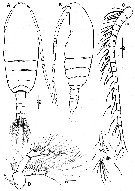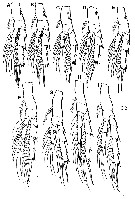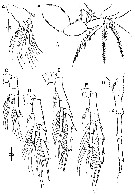|
|
 |
Fiche d'espèce de Copépode |
|
|
Calanoida ( Ordre ) |
|
|
|
Calanoidea ( Superfamille ) |
|
|
|
Paracalanidae ( Famille ) |
|
|
|
Bestiolina ( Genre ) |
|
|
| |
Bestiolina coreana Moon, Lee & Soh, 2010 (F,M) | |
| | | | | | | Ref.: | | | Moon & al., 2010 (p.33, figs.F,M); Soh & al., 2013 (p.57, figs.F,M) |  issued from : S.Y. Moon, W. Lee & H.Y. Soh in Proc. Biol. Soc. Washington, 2010, 123 (1). [p.34, Fig.1]. Female (from 35°22'24''N, 126°20'30''E): A-B, habitus (dorsal and lateral, respectively); C, A1; D, A2. Scale bars in micrometer. Nota : Rostral filaments thick and short. Cephalosome and 1st pedigerous segment fused, 4th and 5th separated. Posterior corners of prosome rounded and with row of spinules posterodorsally. A1 25-segmented, reachingto sdistal part of 3rd urosomite ; ancestral segments II to IV incompletely separated ; segments XXVII-XXVIII comoletely fused. A2 : coxa and basis with 1 and 2 setae, respectively ; endopod 2-segmented, proximal segment with 2 setae and row of spinules subterminally, 7 setae terminally and oblique row of tiny spinules on anterior surface ; exopod 7-segmented, with setal formula : 1, 3, 1, 1, 1, 1, 1+3. Urosome 4-segmented. Genital double-somite symmetrical, as long as wide ; genital operculum located ventroposteriorly. Caudal rami nearly symmetrical, each with 5 setae, lacking setae I and II.
|
 issued from : S.Y. Moon, W. Lee & H.Y. Soh in Proc. Biol. Soc. Washington, 2010, 123 (1). [p.36, Fig.2]. Female: A, Md; B, Mx1; C, Mx2; D, Mxp; E, P5. Scale bars in micrometer. Nota : Md : ganthobase well developed, cutting edge with short teeth and dorsal seta ; basis of palp with 4 setae ; exopod 5-segmented, with setal formula : 1, 1, 1, 1, 2 ; endopod 2-segmented, proximal and distal segments with 4 and 11 setae, respectively. Mx1 : praecoxa and coxa incompletely fused ; praecoxal arthrite with 14 setae, rows of spinules on posterior surface ; coxa with 3 setae on proximal and distal endites, respectively and 9 setae on epipodite ; basis with 4 setae on endite ; endopod and exopod with 14 and 11 setae, respectively. Mx2 : praecoxa and coxa incompletely fused, proximal praecoxal endite with 5 setae, distal and coxal endites with 3 setae each ; basis with 4 setae ; endopod 3-segmented, with 1, 3 and 4 setae on segments 1 to 3, respectively.Mxp : sybcoxa robust, with setal formula : 1, 2, 2, 4 and oblique rows of tiny spinules on posterior surface ; basis with 3 setae and row of spinules on medial surface ; endopod 6-segmented, with setal formula : 2, 3, 4, 3, 3+1, 4.
|
 issued from : S.Y. Moon, W. Lee & H.Y. Soh in Proc. Biol. Soc. Washington, 2010, 123 (1). [p.37, Fig.3]. Female (holotype): A, P1; B, P2; C, P3; D, P4. Scale bars in micrometer.
|
 issued from : S.Y. Moon, W. Lee & H.Y. Soh in Proc. Biol. Soc. Washington, 2010, 123 (1). [p.35]. Female: Setae and spines formula of swimming legs from P1 to P4.
|
 issued from : S.Y. Moon, W. Lee & H.Y. Soh in Proc. Biol. Soc. Washington, 2010, 123 (1). [p.44, Table1]. Presence and number of spinules on the anterior surface of the exopods and endopods of swimming legs 2 - 4.
|
 issued from : S.Y. Moon, W. Lee & H.Y. Soh in Proc. Biol. Soc. Washington, 2010, 123 (1). [p.41, Fig.6]. Female paratype: Variant of number of spinules. A-E, P1; F, G, P3; H, I, P4. Scale bars in micrometer. Nota : There are variations in number of spinules on the posterior surface of coxal, endopodal and exopodal segments of P2 to P4 among individuals from the Yellow Sea.
|
 issued from : S.Y. Moon, W. Lee & H.Y. Soh in Proc. Biol. Soc. Washington, 2010, 123 (1). [p.42, Fig.7, A-D]. SEM micrographs female: A, forehead with rostral filaments (frontal view); B, last pedigerous somite (dorsal view); C, 1st antennular segment with row of spinules; D, P5.
|
 issued from : S.Y. Moon, W. Lee & H.Y. Soh in Proc. Biol. Soc. Washington, 2010, 123 (1). [p.42, Fig.7, E-H]. SEM micrographs female: E-F, last pedigerous somite, right and left, respectively (ventral view); G, genital double-somite (ventral view); H, genital aperture (ventral view). Arrows indicate the spinules and setules.
|
 issued from : S.Y. Moon, W. Lee & H.Y. Soh in Proc. Biol. Soc. Washington, 2010, 123 (1). [p.38, Fig.4]. Male: A-B, habitus (dorsal and lateral, respectively); C, A1; D, A2. Scale bars in micrometer. Nota : Rostral filaments thick (more slender than in female). Prosome-urosome ratio 2.4 :1. Cephalosome bearing dorsal hump. Cephalosome and 1st pedigerous segment fused, 4th and 5th separated. Urosome of 5 free somites, 2 nd urosomal somite longest. Caudal rami nearly symmetrical, about 2 times longer than wide, each with 5 setae, lacking setae I and II. A1 20-segmented, extending to distal part of 2 nd urosomite ; ancestral segments I to IV, V to VIII, and Ix to X completely fused A2 biramous, but atrophied ; coxa and basis fused, with single seta ; endopod 2-segmented, proximal segment without seta, distal one furnished with rows of spinules, subtermunally with 5 setae and terminally 6 setae ; exopod incompletely fused, with 5 setae.
|
 issued from : S.Y. Moon, W. Lee & H.Y. Soh in Proc. Biol. Soc. Washington, 2010, 123 (1). [p.40, Fig.5]. Male: A, Md; B, Mxp; C-F, P1 to P4; G, P5. Scale bars in micrometer. Nota : Md without coxal gnathobase ; basis bearing single seta medially ; exopod 4-segmented with setal formula : 1, 1, 1, 3 : endopod 2-segmented, 1st segment with single seta, 2 nd with 8 setae. Mx1 and Mx2 rudimentary. Mxp : robust syncoxa without setae ; basis with single seta and row of spinules medially ; proximal endopodal segment with 5 setae, of which outer seta robust, distal segment with 4 setae, of which 1 outer and 1 distal setae robust. P5 strongly asymmetrical . Right leg rudimentary. Left leg longer than urosome, uniramous, 5-segmented ; basis and 1st exopodal segment unarmed ; 2 nd with pointed process on distal margin ; terminal one with pointed process and inner long apical spine.
| | | | | Ref. compl.: | | | Moon & al., 2012 (p.1, Table 1, 2, figs.10, 11, seasonal & spatial variations) | | | | NZ: | 1 | | |
|
Carte de distribution de Bestiolina coreana par zones géographiques
|
| | | | | | | Loc: | | | Yellow Sea (SW of coastal waters of Korea, Muan Bay) | | | | N: | 3 | | | | Lg.: | | | (1042) F: 0,90-0,95; M: 0,85-0,96; {F: 0,90-0,95; M: 0,85-0,96} | | | | Rem.: | For Moon & al. (2010, p.39) the species resembles B. sinica (Shen & Lee, 1966), but it differs by the presence/absence of spinules on surface exopodal segments of P2-P4. B. coreana is found predominantly in waters with a temperature greater than 20°C and in salinities ranging from 28 to 32 psu (18.20 - 20.80 p.1000) in the Younggwang coastal region, when a large volume of fresh water flows into the region from the watan and Bulgap rivers. When the salinity increased above 32.0 psu, the species was replaced by Paracalanus parvus s.l. | | | Dernière mise à jour : 21/09/2015 | |
|
|
 Toute utilisation de ce site pour une publication sera mentionnée avec la référence suivante : Toute utilisation de ce site pour une publication sera mentionnée avec la référence suivante :
Razouls C., Desreumaux N., Kouwenberg J. et de Bovée F., 2005-2024. - Biodiversité des Copépodes planctoniques marins (morphologie, répartition géographique et données biologiques). Sorbonne Université, CNRS. Disponible sur http://copepodes.obs-banyuls.fr [Accédé le 26 avril 2024] © copyright 2005-2024 Sorbonne Université, CNRS
|
|
 |
 |












